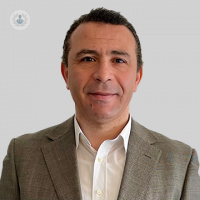What is carotid endarterectomy?
The carotid arteries (also known as carotids) are the main arteries in the human body. They are located at both sides of the neck and their role is to supply the brain with oxygenated blood from the heart.
Sometimes, the carotid arteries by atherosclerosis. That is where there is a build-up of plaques within the blood vessels. The plaques (made of accumulated fat, cholesterol and calcium) can obstruct the arteries, becoming a potential risk factor for thrombosis, embolism, or stroke.
Carotid endarterectomy (CEA) is a surgical procedure used to remove the obstructions within the carotid arteries.

What is it for?
You may have to do a carotid endarterectomy in case of:
- mild to moderate (60 per cent) blockage in the carotids
- a 50 per cent narrowing of the carotids (stenosis) and a history of stroke
What does it involve?
The procedure lasts roughly two hours. You will be either under general or local anaesthetic.
The surgeon will make an incision nearby the obstructed area, temporarily interrupting the blood flow to the carotid to be able to work better. The obstructing plaque will be removed with another cut, then incisions will be sealed with a patch. Finally, the surgeon will restore the blood flow to the carotid.
How can I prepare for a carotid endarterectomy?
Before the surgery, you will have some routine tests to determine where the narrowing or obstruction is. Here are the most common screening tests:
- Carotid ultrasound: a transducer transmitting ultrasound waves will show an image of your carotids
- Carotid angiography: a contrast medium is injected into the carotids, making them visible to X-rays
- Magnetic resonance angiography : much like in a carotid angiography, contrast medium is used to do an MRI scan of the carotids;
- CT angiography : similar to the two previous tests, a CT angiography is a CT scan done with contrast medium.
What is recovery time like?
After the procedure, it is normal to feel some neck pain at the carotids level, as well as trouble ingesting hard foods for a couple of days. You are likely to stay for two days after the surgery.
Usually you will be able to return to work within about three weeks. If the suture stitches are not absorbable, your doctor will tell you when to schedule an appointment to remove them.
What are the alternatives to a carotid endarterectomy?
If the obstruction in a poorly accessible area, or if you are not in a fit enough state for surgery, undergoing a carotid endarterectomy may not be the best option for you. Another option is having a carotid angioplasty.
10-20-2015 07-19-2023Carotid endarterectomy
Ms Sophie Renton - Vascular surgery
Created on: 10-20-2015
Updated on: 07-19-2023
Edited by: Conor Lynch
What is carotid endarterectomy?
The carotid arteries (also known as carotids) are the main arteries in the human body. They are located at both sides of the neck and their role is to supply the brain with oxygenated blood from the heart.
Sometimes, the carotid arteries by atherosclerosis. That is where there is a build-up of plaques within the blood vessels. The plaques (made of accumulated fat, cholesterol and calcium) can obstruct the arteries, becoming a potential risk factor for thrombosis, embolism, or stroke.
Carotid endarterectomy (CEA) is a surgical procedure used to remove the obstructions within the carotid arteries.

What is it for?
You may have to do a carotid endarterectomy in case of:
- mild to moderate (60 per cent) blockage in the carotids
- a 50 per cent narrowing of the carotids (stenosis) and a history of stroke
What does it involve?
The procedure lasts roughly two hours. You will be either under general or local anaesthetic.
The surgeon will make an incision nearby the obstructed area, temporarily interrupting the blood flow to the carotid to be able to work better. The obstructing plaque will be removed with another cut, then incisions will be sealed with a patch. Finally, the surgeon will restore the blood flow to the carotid.
How can I prepare for a carotid endarterectomy?
Before the surgery, you will have some routine tests to determine where the narrowing or obstruction is. Here are the most common screening tests:
- Carotid ultrasound: a transducer transmitting ultrasound waves will show an image of your carotids
- Carotid angiography: a contrast medium is injected into the carotids, making them visible to X-rays
- Magnetic resonance angiography : much like in a carotid angiography, contrast medium is used to do an MRI scan of the carotids;
- CT angiography : similar to the two previous tests, a CT angiography is a CT scan done with contrast medium.
What is recovery time like?
After the procedure, it is normal to feel some neck pain at the carotids level, as well as trouble ingesting hard foods for a couple of days. You are likely to stay for two days after the surgery.
Usually you will be able to return to work within about three weeks. If the suture stitches are not absorbable, your doctor will tell you when to schedule an appointment to remove them.
What are the alternatives to a carotid endarterectomy?
If the obstruction in a poorly accessible area, or if you are not in a fit enough state for surgery, undergoing a carotid endarterectomy may not be the best option for you. Another option is having a carotid angioplasty.


Carotid artery disease: what are the warning signs of a narrowed neck artery?
By Mr S. Tawqeer Rashid
2024-11-21
The carotid arteries are located in your neck and carry blood away from the heart to the head, brain and face. They also transport oxygen to the front parts of the brain that control our movements, feelings and speech. If these get clogged due to fatty deposits - often described as 'furring of the arteries' - it can lead to life-threatening problems. One of our top vascular surgeons, Mr S. Tawqeer Rashid, explains the warning signs and how you can reduce your risk of it developing. See more


Carotid endarterectomy: preventing another stroke
By Mr Mohamed Abdelhamid
2024-11-21
There are certain ways to treat patients following a stroke due to carotid artery disease in order to prevent them from suffering a further stroke. We spoke to Mr Mohamed Abdelhamid, a top consultant vascular and endovascular surgeon, to find out exactly how patients are treated and what the recovery is like following a carotid endarterectomy procedure. See more
Experts in Carotid endarterectomy
-
Professor Alun Davies
Vascular surgeryExpert in:
- Varicose veins
- Deep vein thrombosis (DVT)
- Aortic aneurysms
- Hyperhidrosis
- Venous ulcer
- Carotid endarterectomy
-
Ms Sophie Renton
Vascular surgeryExpert in:
- Diabetic foot
- Varicose veins
- Varicose veins surgery
- Carotid endarterectomy
- Peripheral arterial disease
- Venous ulcer
-
Mr Mohamed Abdelhamid
Vascular surgeryExpert in:
- Varicose veins surgery
- Spider veins (thread veins)
- Aortic aneurysms
- Peripheral arterial disease
- Carotid endarterectomy
- Thoracic outlet syndrome (TOS)
-
Mr Hassan Badri
Vascular surgeryExpert in:
- Varicose veins surgery
- Stroke
- Endovascular surgery
- Peripheral arterial disease
- Diabetic foot
- Aortic aneurysms
- See all

HCA UK at The Shard
HCA UK at The Shard
32 St Thomas Street, SE1 9BS
No existe teléfono en el centro.
By using the telephone number provided by TOP DOCTORS, you automatically agree to let us use your phone number for statistical and commercial purposes. For further information, read our Privacy Policy
Top Doctors

Syon Clinic - part of Circle Health Group
Syon Clinic - part of Circle Health Group
941 Great West Rd, Brentford TW8 9DU
No existe teléfono en el centro.
By using the telephone number provided by TOP DOCTORS, you automatically agree to let us use your phone number for statistical and commercial purposes. For further information, read our Privacy Policy
Top Doctors

The Lister Hospital - part of HCA Healthcare
The Lister Hospital - part of HCA Healthcare
Chelsea Bridge Road, London
No existe teléfono en el centro.
By using the telephone number provided by TOP DOCTORS, you automatically agree to let us use your phone number for statistical and commercial purposes. For further information, read our Privacy Policy
Top Doctors
-
HCA UK at The Shard
32 St Thomas Street, SE1 9BS, Central LondonExpert in:
- Vascular Surgery
- Head and neck cancer
- Breast Cancer
- Orthopaedic surgery
- Thoracic Surgery
- Cancer screening clinic
-
Syon Clinic - part of Circle Health Group
941 Great West Rd, Brentford TW8 9DU, West LondonExpert in:
- Allergies nose and ears
- Allergy Dermatitis
- Allergy
- Clinical analysis
- Anxiety
- Digestive
-
The Lister Hospital - part of HCA Healthcare
Chelsea Bridge Road, London , Central LondonExpert in:
- Cancer
- Cardiology
- Orthopaedic surgery
- Pregnancy
- Physiotherapy
- Women’s health
- See all
- Most viewed diseases, medical tests, and treatments
- Endovenous laser treatment (EVLA)
- Aortic aneurysms
- Botulinum toxin (Botox™)
- Medicolegal
- Transient ischaemic attack (TIA)
- Minimally invasive artery surgery
- Spider veins (thread veins)
- Venous ulcer
- Flushed face
- Hyperhidrosis






